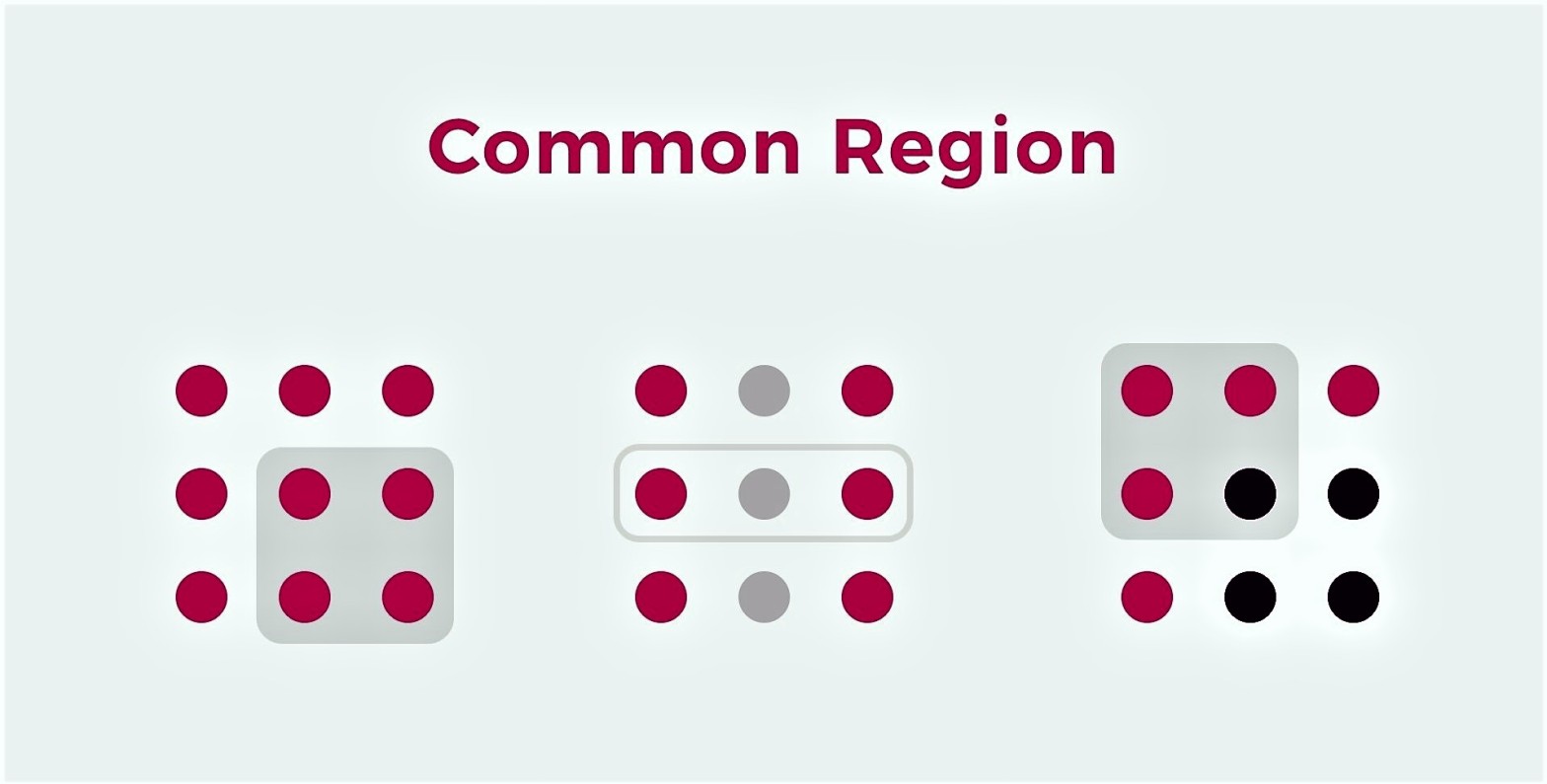Marketing Psychology and Consumer Behaviour
How does the placement of objects an indication of similarity?
Why do we get attracted to things which are more symmetrical and orderly positioned?
How does Law of Common Region and Law of Symmetry & Order influence Consumer’s perception?
Principle of Common Region

Principle of Common Region states that the elements that are connected by uniform visual properties are perceived as being more related than elements that are not connected.
Tweet
Adding borders or other visible barriers is a great way to create a perceived separation between groups of objects—even if they have the same proximity, shape, colour, etc. Alternately, drawing connecting lines (or arrows or some other tangible connecting reference) from one element to the next would have the same effect, as shown above.
The best use of this principle is seen in the newspapers, magazines, and articles, as they have text and images arranged in rows and columns and some may have definite outlines to mark the relatedness of the content. The webpages also have navigation tabs, comments boxes and posts outline that show the disparity of different subject matters.
Principle of Common Region is also used in Satellite Imagery and Aerial Photography which delineates the boundaries of geological structures and man-made buildings based on their infrared reflectance on grayscale, where black and white define extreme ends of the spectrum.

Principle of Symmetry & Order – Law of Prägnanz

Principle of Symmetry & Order also known as Law of Prägnanz (Good Figure) states that the elements arranged on a line or curve are perceived to be more related than elements not on the line or curve.
Tweet
This principle says that our brain perceives ambiguous shapes in as simple a manner as possible. For example, an Olympic logo above is inherently seen as a series of overlapping circles rather than a collection of curved lines.
It is basically a logical flow of ideas and perception. In a way it encompasses all the other Gestalt Principles and gives us a framework to look through all the principles coherently.

Our brain will interpret the image on the left as a rectangle, circle, and triangle, even when the outlines of each are incomplete because these are simpler shapes than the overall image.
In nature, we see things like flocks of birds or schools of fish. They are made up of a bunch of individual elements, but because they move seemingly as one, our brains group them together and consider them a single stimulus logically, thus serving the Law of Prägnanz (Good Figure).

The Gestalt Principles and Perceptual Organization emphasizes, that perception is a personal phenomenon. People exercise selectivity as to which stimuli they perceive, and they organize these stimuli on the basis of certain psychological principles. The interpretation of stimuli is also uniquely individual because it is based on what individuals expect to see, considering their previous experiences, the number of plausible explanations they can envision, and their motives and interests at the time of purchase. Consumers explicate marketers’ offerings using two types of indicators:
A) Intrinsic Cues
Intrinsic cues are physical characteristics of the product itself, such as size, colour, flavour, or aroma. In some cases, consumers use physical characteristics (e.g., the flavour of ice cream or cake) to judge product quality. Consumers like to believe that they base their evaluations of product quality on intrinsic cues, because that enables them to justify their product decisions (either positive or negative) as being “rational” or “objective” choices. For example, the package of Hillshire Farm sliced meat was redesigned after studies showed that consumers want to see the meat and care a lot about how it looks. The new package has a transparent window showing the product. It also has a shallower tub, because consumers perceive neatly fanned-out meat in containers as being of higher quality.
B) Extrinsic Cues
More often consumers use Extrinsic Cues, characteristics that are not inherent in the product, to judge quality. For example, though many consumers claim they buy a brand because of its superior taste, they are often unable to identify that brand in blind taste tests. The colours of such products as powdered fruit drinks and orange juice are a more important determinant than their labels and actual taste in determining the consumers’ ability to identify the flavour correctly. For example, consumers are likely to view purple or grape-coloured drinks as “tart” in flavour, and the orange-coloured version as “flavourful, sweet, and refreshing.”
In the absence of actual experience with a product, consumers often evaluate quality on the basis of cues that are external to the product itself, such as price, brand image, manufacturer’s image, retail store image, or even the perceived country of origin. Stimuli are often highly ambiguous. Some stimuli are weak because of such factors as poor visibility, brief exposure, high noise level, and constant fluctuation. When stimuli are highly ambiguous, an individual will usually interpret them in such a way that they serve to fulfil personal needs, wishes, interests, and so on.
Thus, marketing, branding and label innovation play a crucial role in highly competitive consumer markets. For example, in the beer industry, the product’s package must stand out because over half the purchase decisions are made at the shelf. A study found that consumers engaged most with illustrations and logos, and less with package copy.
So now when you are ready to make a purchase decision, make sure you have the Marketing Bible in hand!!
Related Posts
Gestalt Psychology and Its Impact on Consumer Behaviour: I – Closure and Continuation
Gestalt Psychology and Its Impact on Consumer Behaviour: II – Proximity and Similarity
Gestalt Psychology and Its Impact on Consumer Behaviour: III – Figure & Ground
Marketing Psychology and Consumer Behaviour

Murtaza Choolawala
Geologist, Marketer
Hi, I am Murtaza, an enthusiastic researcher. Always curious to learn new things and to connect with people. Tech and Marketing are my obsession, and Research and Analysis are my Passion.





2 thoughts on “Gestalt Psychology and Its Impact on Consumer Behaviour: IV – Common Region and Symmetry and Order”